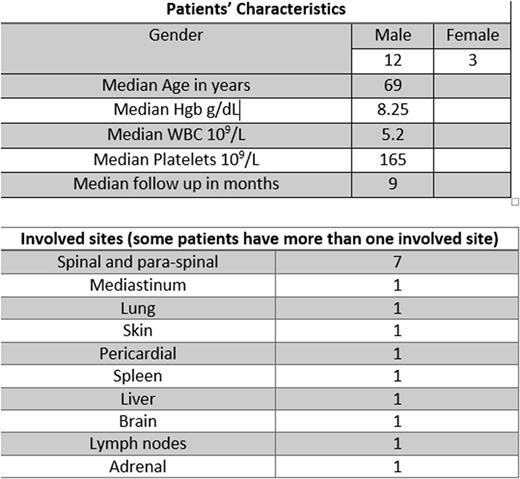Abstract
Introduction: Extramedullary hematopoiesis (EMH) is the proliferation of hematopoietic tissue outside the bone marrow (BM). They are primarily seen in patients with chronic hemolytic anemia, for example, thalassemia and sickle cell disease. It's also reported with myeloproliferative neoplasms (MPN), especially in primary myelofibrosis. The mechanism behind it is the reactive and compensatory expansion of hematopoietic tissue outside the BM. EMH associated with myelodysplastic syndrome (MDS) has only been reported as case reports
Methodology: A literature search was performed for English language articles using PubMed, Scopus, and Google Scholar, for any date up to June 2022. The following keywords were used "(Myelodysplasia), (Myelodysplastic syndrome), (MDS), (extramedullary hematopoiesis), (EMH)".
Results: Fifteen cases were reported. Males were predominant with 12 (80%) patients, with a median age of 69 years. Complete blood count (CBC) showed a median hemoglobin (Hgb) of 8.5 g/dL, a median white blood cell count of 8 x109/L, and a median platelet count of 165 x109/L. MDS subtypes were ring sideroblasts in 6 (40%) patients and MDS/MPN in 4 (26%) patients. The most common affected site was para-spinal area in 7 (46%) patients, while other areas includes the mediastinum, lung, skin, pericardium, spleen, liver, brain, and lymph nodes. Computed tomography (CT) was the most common used imaging modality for diagnosis in 7 (46%) patients, followed by a biopsy to the affected site in most cases. Five (33%) patients received surgical treatment, 4 (26%) radiation therapy and 3 (20%) steroids treatment. TreatmenResponses to interventions showed improvement in 8 (53%) patients. Two patients' conditions remained stable while another two progressed. For overall survival, six (40%) patients reported alive and four (26%) dead. The average duration of follow-up for the cases was nine months.
Conclusion: MDS associated Extramedullary hematopoiesis (EMH) is extremely rare. However, it should be thought of and kept in mind as a differential diagnosis. Early diagnosis and management is warranted as it could involve vital organs leading to increase morbidity and mortality. There is no consensus or guidelines for treatment so far. Male with anemia and ring sideroblasts MDS type were more frequent and can be considered as a risk factors for EMH in MDS.
Disclosures
No relevant conflicts of interest to declare.
Author notes
Asterisk with author names denotes non-ASH members.


